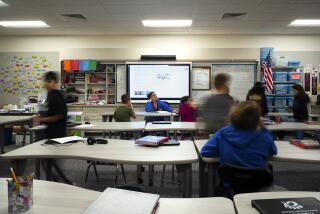Solving Public School Problems
- Share via
Teacher Betty Raskoff Kazmin appears to have a remarkably narrow vision as to what currently ails the public schools (“Don’t Blame the Mirror for Flaws,” Commentary, Nov. 24).
Her students at a Los Angeles magnet school are highly motivated, diligent and cooperative, she asserts. Their parents are careful to “motivate, encourage and prepare” them for schoolwork. However, these students, parents, and even the administrators of Kazmin’s school, are not “unique,” she avers.
While it is not the case at her school, a lack of “material resources” in schools is the cause of the present decline in educational achievement, Kazmin has deduced. This one-sided view of the reasons for falling school performance unfortunately does not bear up under analytic scrutiny.
In San Diego, for example, the schools with the worst academic achievement records are the ones that receive the largest payments per student. In this regard, I calculated a statistical coefficient of correlation of only .04 between the dropout rates in the 50 states and how much they spent per student. This figure suggests that there is no relationship between expenditures per student across the country and student achievement.
Pleading with business leaders and the media to persuade taxpayers to provide more money for the schools, as Kazmin recommends, thus is not likely to solve our educational problems.
PATRICK GROFF, Professor, School of Teacher Education, San Diego State University
More to Read
Sign up for Essential California
The most important California stories and recommendations in your inbox every morning.
You may occasionally receive promotional content from the Los Angeles Times.













